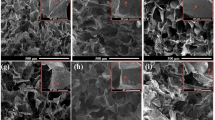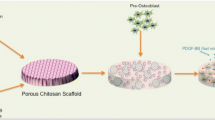Abstract
The present work is focused on the design of a bioactive chitosan-based scaffold functionalized with organic and inorganic signals to provide the biochemical cues for promoting stem cell osteogenic commitment. The first approach is based on the use of a sequence of 20 amino acids corresponding to a 68–87 sequence in knuckle epitope of BMP-2 that was coupled covalently to the carboxyl group of chitosan scaffold. Meanwhile, the second approach is based on the biomimetic treatment, which allows the formation of hydroxyapatite nuclei on the scaffold surface. Both scaffolds bioactivated with organic and inorganic signals induce higher expression of an early marker of osteogenic differentiation (ALP) than the neat scaffolds after 3 days of cell culture. However, scaffolds decorated with BMP-mimicking peptide show higher values of ALP than the biomineralized one. Nevertheless, the biomineralized scaffolds showed better cellular behaviour than neat scaffolds, demonstrating the good effect of hydroxyapatite deposits on hMSC osteogenic differentiation. At long incubation time no significant difference among the biomineralized and BMP-activated scaffolds was observed. Furthermore, the highest level of Osteocalcin expression (OCN) was observed for scaffold with BMP2 mimic-peptide at day 21. The overall results showed that the presence of bioactive signals on the scaffold surface allows an osteoinductive effect on hMSC in a basal medium, making the modified chitosan scaffolds a promising candidate for bone tissue regeneration.







Similar content being viewed by others
References
Baksh D,Yao R,Tuan RS, Comparison of proliferative and multilineage differentiation potential of human mesenchymal stem cells derived from umbilical cord and bone marrow. Stem Cells. 2007;25:1384–1392.
Ruckh TT,Kumar K,Kipper MJ,Popat KC, Osteogenic differentiation of bone marrow stromal. Acta Biomater. 2010;6:2949–2959.
Raucci MG, Giugliano D, Alvarez-Perez MA, Ambrosio L. Effects on growth and osteogenic differentiation of mesenchymal stem cells by the strontium-added sol–gel hydroxyapatite gel materials. J Mater Sci Mater Med. 2015;26:1–11.
Raucci MG,Alvarez-Perez MA,Meikle S,Ambrosio L,Santin M, Poly(Epsilon-Lysine) dendrons tethered with phosphoserine increase mesenchymal stem cell differentiation potential of calcium phosphate gels. Tissue Eng Part A. 2014;20:474–485.
D’Antò V,Raucci MG,Guarino V,Martina S,Valletta R,Ambrosio L, Behaviour of human mesenchymal stem cells on chemically synthesized HA–PCL scaffolds for hard tissue regeneration. J Tissue Eng Regen Med. 2016;10:E147–154.
Demitri C,Raucci MG,Giuri A,De Benedictis VM,Giugliano D,Calcagnile P,Sannino A,Ambrosio L, Cellulose-based porous scaffold for bone tissue engineering applications: assessment of hMSC proliferation and differentiation. J Biomed Mater Res Part A. 2016;104:726–733.
Raucci MG,Alvarez-Perez MA,Demitri C,Sannino A,Ambrosio L, Proliferation and osteoblastic differentiation of hMSCs on cellulose-based hydrogels. J Appl Biomater Funct Mater. 2012;10:302–307.
Oryan A, Alidadi S, Bigham-Sadegh A, Moshiri A. Comparative study on the role of gelatin, chitosan and their combination as tissue engineered scaffolds on healing and regeneration of critical sized bone defects: an in vivo study. J Mater Sci Mater Med. 2016;27(10):155.
Cárdenas G,Anaya P,von Plessing C,Rojas C,Sepúlveda J, Chitosan composite films. Biomedical applications. J Mater Sci Mater Med. 2008;19(6):2397–2405.
Li Y,Chen XG,Liu N,Liu CS,Liu CG,Meng XH,Yu LJ,Kenendy JF, Physicochemical characterization and antibacterial property of chitosan acetates. Carbohydr Polym. 2007;67:227–232.
Altiok D,Altiok E,Tihminlioglu F, Physical, antibacterial and antioxidant properties of chitosan films incorporated with thyme oil for potential wound healing applications. J Mater Sci Mater Med. 2010;21(7):2227–2236.
Thein-Han WW,Misra RDK, Biomimetic chitosan–nanohydroxyapatite composite scaffolds for bone tissue engineering. Acta Biomater. 2009;5:1182–1197.
Shi C,Zhu Y,Ran X,Wang M,Su Y,Cheng T, Therapeutic potential of chitosan and its derivatives in regenerative medicine. J Surg Res. 2006;133:185–192.
Pillai CKS,Paul W,Sharma CP, Chitin and chitosan polymers: chemistry, solubility and fiber formation. Prog Polym Sci. 2009;34:641–678.
Hutmacher DW, Scaffolds in tissue engineering bone and cartilage. Biomaterials. 2000;21:2529–2543.
Yang X, Tare RS, Partridge KA, Roach HI, Clarke NM, Howdle SM, Shakesheff KM, Oreffo RO. Induction of human osteoprogenitor chemotaxis, proliferation, differentiation, and bone formation by osteoblast stimulating factor-1/pleiotrophin: osteoconductive biomimetic scaffolds for tissue engineering. J Bone Miner Res. 2003;18:47–57.
Deb Sl, Mandegaran R, Di Silvio L. A porous scaffold for bone tissue engineering/45S5 Bioglass derived porous scaffolds for co-culturing osteoblasts and endothelial cells. J Mater Sci Mater Med. 2010;21(3):893–905.
Kieber-Emmons T,Murali R,Greene MI, Therapeutic peptides and peptidomimetics. Curr Opin Biotechnol. 1997;8:435–441.
Lee JY,Choi YS,Lee SJ,Chung CP,Park YJ, Bioactive peptide-modified biomaterials for Bone Regeneration. Curr Pharm Des. 2011;17:2663–2676.
Kosen Y,Miyaji H,Kato A,Sugaya T,Kawanami M, Application of collagen hydrogel/sponge scaffold facilitates periodontal wound healing in class II furcation defects in beagle dogs. J Periodontal Res. 2012;47:626–634.
Demitri C, Giuri A, De Benedictis VM, Raucci MG, Giugliano D, Sannino A, Ambrosio L. Microwave-induced porosity and bioactivation of chitosan-PEGDA scaffolds: morphology, mechanical properties and osteogenic differentiation. J Tissue Eng Regen Med. 2017;11:86–98.
Dhoot NO, Tobias CA, Fischer I, Wheatley MA. Peptide-modified alginate surfaces as a growth permissive substrate for neurite outgrowth. J Biomed Mater Res. 2004;71A:191–200.
Abu Bakar MS,Cheng MHW,Tang SM,Yu SC,Liao K,Tan CT,Khor KA,Cheang P, Tensile properties, tension–tension fatigue and biological response of polyetheretherketone–hydroxyapatite composites for load-bearing orthopedic implants. Biomaterials . 2003;24:2245–2250.
Lickorish D, Ramshaw JAM, Werkmeister JA, Glattauer V, Howlett CR. Collagen–hydroxyapatite composite prepared by biomimetic process. J Biomed Mater Res. 2004;68:19–27.
Sun F,Zhou H,Lee J, Various preparation methods of highly porous hydroxyapatite/polymer nanoscale biocomposites for bone regeneration. Acta Biomater. 2011;7:3813–3828.
Manferdini C,Guarino V,Zini N,Raucci MG,Ferrari A,Grassi F,Gabusi E,Squarzoni S,Facchini A,Ambrosio L,Lisignoli G, Mineralization behavior with mesenchymal stromal cells in a biomimetic hyaluronic acid-based scaffold. Biomaterials. 2010;31:3986–3996.
Demitri C, Giuri A, Raucci MG, Giugliano D, Madaghiele M, Sannino A, Ambrosio L. Preparation and characterization of cellulose-based foams via microwave curing. Interface Focus. 2014;4:20130053.
Yan S,Yin J,Cui L,Yang Y,Chen X, Apatite-forming ability of bioactive poly(L-lactic acid)/grafted silica nanocomposites in simulated body fluid. Colloids Surf B Biointerfaces. 2011;86:218–224.
Catauro M,Raucci MG,Ausanio G,Ambrosio L, Sol-gel synthesis, characterization and bioactivity of poly (ether-imide)/TiO2 hybrid materials. J Appl Biomater Biomech. 2006;5:41–48.
Tanahashi M, Hata K, Minoda M, Miyamoto T (eds) Effect ofsubstrate on apatite forming by a biomimetic process. Bioceramics, Vol. 5. Kobunshi Kankokai, Kyoto, 1992. pp. 57–64..
Agrawal CM,Ray RB, Biodegradable polymeric scaffolds for musculoskeletal tissue engineering. J Biomed Mater Res. 2001;55:141–150.
Barrere F,van Blitterswijk CA,de Groot K,Layrolle P, Nucleation of biomimetic Ca–P coatings on Ti6Al4V from a SBFx5 solution: influence of magnesium. Biomaterials. 2002;23:2211–2220.
Lian JB, Stein GS. Concepts of osteoblast growth and differentiation: basis for modulation of bone cell development and tissue formation. Crit Rev Oral Biol Med. 1992;3:269–305.
Maegawa N,Kawamura K,Hirose M,Yajima H,Takakura Y,Ohgushi H, Enhancement of osteoblastic differentiation of mesenchymal stromal cells cultured by selective combination of bone morphogenetic protein-2 (BMP-2) and fibroblast growth factor-2 (FGF-2). J Tissue Eng Regen Med. 2007;1:306–313.
Kang W, Lee DS, Jang JH. Evaluation of sustained BMP-2 release profiles using a novel fluorescence-based retention assay. PLoS One. 2015;10:e0123402.
Satarkar NS, Zach Hilt J. Hydrogel nanocomposites as remote-controlled biomaterials. Acta Biomater. 2008;4:11–16.
Vo TN,Kurtis KF,Mikos AG, Strategies for controlled delivery of growth factors and cells for bone regeneration. Adv Drug Deliv Rev. 2012;64:1292–1309.
Acknowledgements
This study has received funding from the PNR-CNR Aging Program 2012–2018. The authors also thank Mrs. Cristina Del Barone for facilitating microscopy analysis, Mrs Stefania Zeppetelli for supporting of biological investigations and Dr. Luca D’Andrea for HPLC and mass spectrometry investigations at Institute of Biostructure and Bioimaging (IBB) in Naples, Italy.
Author information
Authors and Affiliations
Corresponding authors
Ethics declarations
Conflict of interest
The authors declare that they have no conflict of interest.
Additional information
These authors contributed equally: Alessandra Soriente and Ines Fasolino.
Rights and permissions
About this article
Cite this article
Soriente, A., Fasolino, I., Raucci, M.G. et al. Effect of inorganic and organic bioactive signals decoration on the biological performance of chitosan scaffolds for bone tissue engineering. J Mater Sci: Mater Med 29, 62 (2018). https://doi.org/10.1007/s10856-018-6072-2
Received:
Accepted:
Published:
DOI: https://doi.org/10.1007/s10856-018-6072-2




